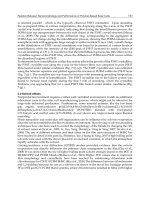torque control Part 5 docx
Bạn đang xem bản rút gọn của tài liệu. Xem và tải ngay bản đầy đủ của tài liệu tại đây (5.36 MB, 20 trang )
Torque Control
70
1200 rpm is given to the drive and the motor reaches again another operation point
(1200rpm/400Nm). Finally, the controllers are tested to step load torque disturbance. It is
easy, therefore, to come to the conclusion that fuzzy speed controller has a remarkably
better response than the classic PI speed controller.
The system was also investigated during the starting period and its control under different
commutative periods. In this fig. 17 it is shown that the torque of the motor has lower ripple
when the speed estimation is being carried out using a fuzzy PI controller.
0 0. 5 1 1. 5 2 2. 5 3
0
500
1000
1500
Torque (Nm)
I. Conventional PI controller
(a)
0 0. 5 1 1. 5 2 2. 5 3
0
500
1000
1500
Motor Speed (rpm)
(b)
0 0. 5 1 1. 5 2 2. 5 3
-600
-400
-200
0
200
400
600
Current i
a
(A)
(c)
0 0. 5 1 1. 5 2 2. 5 3
0
0. 2
0. 4
0. 6
0. 8
1
1. 2
Time (s)
Flux (Wb)
(d)
Te
Te*
T
L
ω
r
ω
r
*
ψ
s
ψ
s
*
0 0. 5 1 1. 5 2 2. 5 3
0
500
1000
1500
Torque (Nm)
II. Fuzzy Logic controller
(a)
0 0. 5 1 1. 5 2 2. 5 3
0
500
1000
1500
Motor Speed (rpm)
(b)
0 0. 5 1 1. 5 2 2. 5 3
-600
-400
-200
0
200
400
600
Current i
a
(A)
(c)
0 0. 5 1 1. 5 2 2. 5 3
0
0. 2
0. 4
0. 6
0. 8
1
1. 2
Time (s)
Flux (Wb)
(d)
Te
Te*
T
L
ω
r
ω
r
*
ψ
s
ψ
s
*
Fig. 17. Motor control response with steps of speed command and load torque. (a)
Electromagnetic torque
e
T , speed controller output
*
e
T
, load torque TL, (b) actual motor
speed
r
ω
, reference speed
*
r
ω
,(c) stator current i
sa
in phase a (d) stator flux magnitude
s
Ψ ,
and reference value
*
s
Ψ
.
Fig. 18 shows, in more detail, the comparison of the motor speed response using the two
different speed controllers, during steps of speed command
ω
r
*
and load torque. To
investigate the system for the classic PI controller more than one pairs of values Kp and Ki
have been used. The two controllers were tested in a wide range of engine speed. Extending,
namely, from a very low speed to a very high speed of the motor. It was observed, that the
fuzzy PI controller has better performance than the classic PI controller.
In fig. 19 we observe that the acceleration of the motor using the classic PI speed controller is
almost the same, independently of command step, and generally a linearity is observed,
which depends only on the load on the axis of motor. In other words we have the maximum
acceleration of the motor under these conditions. This means that when we have a small
(
a
)
(
b
)
Direct Torque Control using Space Vector Modulation
and Dynamic Performance of the Drive, via a Fuzzy Logic Controller for Speed Regulation
71
0 0.5 1 1.5 2 2.5 3
0
200
400
600
800
1000
1200
1400
time (sec)
motor speed (rpm)
Classic PI
Fuzzy PI
ω
r
*
Fig. 18. Motor speed control response with steps of speed command and load torque.
0.34 0.36 0.38 0.4 0.42 0.44 0.46
0.65
0.7
0.75
0.8
0.85
0.9
0.95
1
1.05
1.1
Time (sec)
Rotor Speed (pu)
Fuzzy PI
Classic PI
Fig. 19. Dynamic behaviour of classic PI and Fuzzy PI controller during motor startup. Load
in the shaft of the motor equal with 50% nominal and various step changes of speed.
Torque Control
72
Classic PI Fuzzy PI
(a1) (a2)
(b1) (b2)
Fig. 20. Simulation results of the speed controller response in various speed step commands.
(1) Classic PI controller, (2) Fuzzy PI controller. (a) 30%, (b) 20%
load in the shaft of the motor and the step is small, then an overshoot in the speed of the
motor is observed. On the contrary, with the fuzzy PI of controller, we observe an
acceleration that depends on the step of command and the load on the shaft. In fig. 20 an
analytical comparison of the dynamic performance of the control system is presented. The
system behavior can be studied when the motor speed increases, while the load torque in
the motor shaft remains constant at 50% of the nominal load. In more detail, the dynamic
0.3 0.35 0.4 0.45 0.5 0.55 0.6
0
0.5
1
1.5
2
Torque (pu)
0.3 0.35 0.4 0.45 0.5 0.55 0.6
0.7
0.8
0.9
1
1.1
Ti me (s ec)
Rotor Speed (pu)
0.3 0.35 0. 4 0.45 0.5 0. 55 0.6
0
0.5
1
1.5
2
Torque (pu)
0.3 0.35 0. 4 0.45 0.5 0. 55 0.6
0.7
0.8
0.9
1
1.1
Ti me (s ec)
Rotor Speed (pu)
Te
Te*
T
L
ω
r
*
ω
r
0.3 0.35 0.4 0.45 0.5 0.55 0.6
0
0.5
1
1.5
2
Torque (pu)
0.3 0.35 0.4 0.45 0.5 0.55 0.6
0.7
0.8
0.9
1
1.1
Ti me ( sec)
Rotor Speed (pu)
0.3 0.35 0. 4 0.45 0.5 0.55 0. 6
0
0.5
1
1.5
2
Torque (pu)
0.3 0.35 0. 4 0.45 0.5 0.55 0. 6
0.7
0.8
0.9
1
1.1
Ti me ( sec)
Rotor Speed (pu)
Te
Te*
T
L
ω
r
*
ω
r
Direct Torque Control using Space Vector Modulation
and Dynamic Performance of the Drive, via a Fuzzy Logic Controller for Speed Regulation
73
performance of the two speed controllers, classic PI and fuzzy PI, is presented during
increase of the motor speed by 30%, 20% and 10% step commands of the nominal speed
respectively. In this figure, the improvement in motor acceleration and the change in motor
torque using the fuzzy PI controller can be seen. Classic PI controller shows an undesirable
overshoot of the actual speed. On the other hand, fuzzy PI controller has a smoother
response. The output of each controller is the value of the reference electromagnetic torque
*
e
T
. The change in motor speed is the result of applying the produced reference torque to
the DTC scheme.
7. Direct torque control for three level inverters
7.1 Control strategy of DTC three-level inverter
The applications of inverter three or multiple level inverters have the advantage of reducing
the voltage at the ends of semiconductor that mean the inverters can supply engines with
higher voltage at the terminals of the stator. Also, the three level inverters show a bigger
number of switching states. A three level inverter shows 3
3
=27 switching states. This means
an improvement in the higher harmonics in the output voltage of the inverter and hence
fewer casualties on the side of the load and less variation of electromagnetic torque. In
direct torque control for a two-level inverter there is no difference between large and small
errors of torque and flux. The switching states selected by the dynamics of drive system
with the corresponding change of desired torque and flux reference is the same as those
chosen during the operation in steady state. For the three-level voltage inverter is a
quantification of the input variables. In this case, increasing the torque on the control points
of the hysteresis comparators in five (Figure 21) and the three magnetic flux (Figure 22).
Also divided the cycle recorded by electromagnetic flow of the stator in a rotating, in 12
areas of 30º as shown in Figure 23. This combined with the increased number of operational
situations, for three-level inverter is 27 and is expressed in 19 different voltage vectors can
be achieved better results. Figure 24a shows the 19 voltage vectors for the three level voltage
source inverter of figure 25, and the vector of magnetic flux of the stator Ψs. It should be
noted that in Figure 24a vectors V1, V2, V3, V4, V5, V6 shown each for two different
operating conditions and the zero vector V0 for three different situations. The angle the
vector i in relation to the axis a is less than 30º. The possible changes in magnetic flux stator
which can be achieved using the voltage vectors of operating conditions shown in 24b.
From Figures 24.a and 24b seems to change the value of stator flux
Ψs in a new value
should be selected the following voltage vectors. If an increase in the flow can be achieved
by applying one of the voltage vectors
V9, V2, V8, V1, V7, because in this case, the new
vector of stator flux will be correspondingly
Ψs+ΔΨ9, Ψs+ΔΨ2, Ψs+ΔΨ8, Ψs+ΔΨ1,
Ψs+ΔΨ7. By the same token if we can achieve a reduction of magnetic flux should
implement one of the voltage vectors
V14, V5, V15, since in this case the new vector of
stator flux is είναι
Ψs+ΔΨ14, Ψs+Ψ5, Ψs+ΔΨ15, which is less than the original Ψs. Also
for the electromagnetic torque, taking into account the equation 6, if is necessary very sharp
increase in torque, then we can apply one from the voltage vectors
V11, V3, V12 because it
will grow along with the flow and the angle between the vectors δ of stator flux and the
rotor. If a reduction of the torque is needed we can apply one from the voltage vectors
V6,
V17, V18. By the same token if is required large increase in flow and a slight increase in
torque can do a combination of the above and apply the vector
V8 or if stator magnetic flux
is constant and requires a small reduction of the torque is needed can be chosen one from
Torque Control
74
Fig. 21. Hysteresis comparator 5 level for the electromagnetic flux
Fig. 22. Hysteresis comparator 3 level for the magnetic flux
Fig. 23. Sectors of Statorsmagnetic flux.
Direct Torque Control using Space Vector Modulation
and Dynamic Performance of the Drive, via a Fuzzy Logic Controller for Speed Regulation
75
(a) (b)
Fig. 24. a) voltage vectors of 3 level voltage b) changes of the stator’s flux with the vector of
each switching state.
Fig. 25. Three- level voltage source inverter
zero voltage vectors
V0. Of course the number of vectors that can bring the desired change
in magnetic flux in stator and electromagnetic torque varies to the angle the vector of
magnetic flux on the axis A. As is natural in such cases there are other suitable candidate
voltage vectors. The correct choice of the vectors, depending on the desired change in the
flow and torque that we want to do, depending on the sector in which the vector of the flow,
Torque Control
76
it is the biggest challenge to build such a table in direct torque control for drive systems
powered by three-level voltage inverters. So the inverter three-level table is not widely
accepted for pulsing as in the case of two-level inverters.
Based on the above logic while taking into account the intersection of Figure 3 in which may
be in the vector of the stator magnetic flux, it became the table I.
Flux(
ψ
S
) Torque(T
e
) S1 S2 S3 S4 S5 S6 S7 S8 S9 S10 S11 S12
-2 V0 V0 V0 V0 V0 V0 V0 V0 V0 V0 V0 V0
-1 V3 V4 V4 V5 V5 V6 V6 V1 V1 V2 V2 V3
-1 0 V3 V4 V4 V5 V5 V6 V6 V1 V1 V2 V2 V3
1 V11 V12 V13 V14 V15 V16 V17 V18 V7 V8 V9 V10
2 V11 V12 V13 V14 V15 V16 V17 V18 V7 V8 V9 V10
-2 V0 V0 V0 V0 V0 V0 V0 V0 V0 V0 V0 V0
-1 V2 V3 V3 V4 V4 V5 V5 V6 V6 V1 V1 V2
0 0 V2 V3 V3 V4 V4 V5 V5 V6 V6 V1 V1 V2
1 V10 V11 V12 V13 V14 V15 V16 V17 V18 V7 V8 V9
2 V10 V11 V12 V13 V14 V15 V16 V17 V18 V7 V8 V9
-2 V0 V0 V0 V0 V0 V0 V0 V0 V0 V0 V0 V0
-1 V2 V3 V3 V4 V4 V5 V5 V6 V6 V1 V1 V2
1 0 V2 V3 V3 V4 V4 V5 V5 V6 V6 V1 V1 V2
1 V9 V11 V11 V13 V13 V15 V15 V17 V17 V7 V7 V9
2 V9 V11 V11 V13 V13 V15 V15 V17 V17 V7 V7 V9
Table Ι
7.2 Simulation of the system in the computer
The drive system considered consists of three-phase asynchronous motor, three phase three
level voltage inverter and control circuit with hysteresis comparators electromagnetic torque
and flux of Figures 21 and 22 respectively. The system design was done by computer
simulation with Matlab / Simuling. Figure 26 shows the general block diagram of the
simulation.
By simulating the drive system on the computer can pick up traces of electromechanical
sizes in both permanent and transition state in the system. From the curves can be drawn for
the behavior of both the load response and the response speed. Details of the induction
motor and inverter with three levels that will make computer simulations are shown in
Tables II and III respectively.
7.3 Simulation resuls
In this text we will present the waveforms of electromechanical changes in the size of the
load. To investigate the behavior of the electric drive system in response to load change
incrementally load of 25 Nm to 30Nm, then by 30Nm to 25 Nm, maintaining the engine
speed steady at 1000 rpm. Figure 27 shown the electromagnetic torque and Figure 8, the
engine speed according to the time when the transition state in which they affect the load.
Direct Torque Control using Space Vector Modulation
and Dynamic Performance of the Drive, via a Fuzzy Logic Controller for Speed Regulation
77
Fig. 26. Block diagram DTC Three-level Inverter in the Simulink with speed estimator.
Nominal power
P = 4000W
Stator phase voltage
V = 460 V
Ohmic resistance of stator
R
s
= 1.405 Ω
Ohmic resistance of rotor
R
r
= 1.395 Ω
Main magnetic induction
L
m
= 172.2x10
-3
H
Stator leakage inductance
L
ls
= 5.84x10
-3
H
Motor leakage inductance
L
lr
= 5.84x10
-3
H
Leakage torque
J = 0.0131 Kg.m
2
Coefficient of friction
F = 0.002985 Nms
Number of poles
P = 4 (two pairs of poles)
Table ΙΙ. Nominal details of induction motor
Semiconductor
IGBT with antiparallel diodes
Ohmic resistance Snubber
R
s
= 1000 Ω
Capacitance Snubber
C
s
= infinite
Internal resistance semiconductor
Ron = 0.001 Ω
IGBT voltage crossing
V
f
= 0.8 V
Diode voltage crossing
V
f
= 0.8 V
Table ΙΙΙ. Nominal details of inverter
Torque Control
78
Fig. 27. Electromagnetic flux, reference flux and load flux versus time
Fig. 28. Speed reference and actual speed versus time
Direct Torque Control using Space Vector Modulation
and Dynamic Performance of the Drive, via a Fuzzy Logic Controller for Speed Regulation
79
Fig. 29. Electromagnetic stator flow versus time.
By changing the load observed a slight, temporary change of speed. Figure 9 shows the
change of the stator flux versus time and Figure 30 is the change of magnetic flux in the
stator three-axis system that is α,β system versus time. Figure 31 shows the change of the
vector current in the stator system. In this figure shows the change of the modulus of vector
power to change the load. When the torque load is reduced and the measure of the vector
current and increase the vector of power when the load increases.
Fig. 30. Electromagnetic flow in the stator ιν α,β system is a function of time
Torque Control
80
Fig. 31. Current in the stator in α,β reference system
8. Conclusion
This paper has presented a modified Direct Torque Control method for PWM-Inverter fed
asynchronous motor drive using constant switching frequency. Constant-switching-
frequency is achieved by using space vector modulation and finally, an SVM based DTC
system, compared to the classic DTC scheme for torque control. DTC-SVM schemes improve
considerably the drive performance in terms of reducing torque and flux pulsations, reliable
startup and low-speed operation, well-defined harmonic spectrum, and radiated noise.
Therefore, DTC-SVM is an excellent solution for general-purpose asynchronous motor
drives. On the contrary, the short sampling time required by the classic DTC schemes makes
them suited to very fast torque- and flux-controlled drives because of the simplicity of the
control algorithm. When a speed control mode instead of torque control is needed, a speed
controller is necessary for producing the reference electromagnetic torque value. For this
purpose a fuzzy logic based speed controller is used. Fuzzy PI speed controller has a more
robust response, compared to the classic PI controller, in a wide range area of motor speed.
9. References
Takahashi I. & Noguchi T.(1986): A new quick-response and high efficiency control strategy of an
induction machine
, IEEE Trans. Ind. Applicat., vol. 22, pp. 820–827, Sep./Oct.
Bimal K. & .Bose (2002).
Modern Power Electronics And AC Drives. Prentice Hall.
Andrzej M. & Trzynadlowsky (2002)
.Control of Induction Motors. Academic Press.
Boldea I. &.Nasar S.A. (1998 ).
Electric Drives, CRC Press,.
Casadei D., et al.,(2002).
FOC and DTC: Two viable schemes for induction motors torque control,
IEEE Trans. Power Electron., vol. 17, pp. 779–787, Sept
Direct Torque Control using Space Vector Modulation
and Dynamic Performance of the Drive, via a Fuzzy Logic Controller for Speed Regulation
81
Casadei D., et al., (2000). Implementation of a Direct Torque Control Algorithm for Induction
Motors Based on Discrete Space Vector Modulation
, IEEE Trans. Ind. Applicat., vol. 15,
No.4 pp. 769–777, July.
Giuseppe S. et al. (2004).
Diret Torque Control of PWM Inverter-Fed AC Motors – A survey, IEEE
Trans. Ind. Applicat., vol. 51, pp. 744–757, Aug
Koutsogiannis Z., et al., (2006).
Computer Analysis of a Direct Torque Control Induction Motor
Drive Using a Fuzzy Logic Speed Controller,
XVII International Conference on
Electrical Machines, Sept
Brahmananda T. et al, (2006),
Sensorless Direct Torque Control of Induction Motor based on
Hybrid Space Vector Pulsewidth Modulation to Reduce Ripples and Switching Losses – A
Variable Structure Controller Approach
, IEEE Power India Conference, 10-12 Apr
Chen L., et al., (2005).
A scheme of fuzzy direct torque control for induction machine, IEEE
Proceedings of the Fourth International Conference on Machine Learning and
Cybernetics, Guangzhou, 18-21 Aug
Mitronikas E. & Safacas A., (2004).
A Hybrid Sensorless Stator-Flux Oriented Control Method for
Induction Motor Drive
, in 35th Annual IEEE Power Electronics Specialists
Conference (PESC’04), June 20-25, , Aachen, Germany, pp. 3481-3485.
Grabowski P., (2000).
A Simple Direct Torque Neuro Fuzzy Control of PWM Inverter Fed
Induction Motor Drive
, IEEE Trans. Ind. Electron., Vol. 47, No. 4, pp. 863-870, Aug
Romeral L., et al. (2003).
Novel Direct Torque Control (DTC) Scheme With Fuzzy Adaptive
Torque-Ripple Reduction
, IEEE Trans. Ind. Electron., vol.50, pp.487–492,Jun
Ortega M., et al., (2005).
Direct Torque Control of Induction Motors using Fuzzy Logic with
current limitation
, IEEE Industrial Electronics Society, IECON 2005. 32nd Annual
Conference.
Mitronikas E. & Safacas A., (2001).
A New Stator Resistance Tuning Method for Stator-Flux-
Oriented Vector-Controlled Induction Motor Drive
, IEEE Transaction on Industrial
Electronics, Vol. 48, No. 6, December 2001, pp. 1148 – 1157.
Mitronikas E. & Safacas A., (2005)
. An improved Sensorless Vector Control Method for an
Induction Motor Drive
, IEEE Transaction on Industrial Electronics, Vol. 52, Νο. 6,
December, pp. 1660-1668.
Miloudi A., et.al., (2004). Simulation and Modelling of a Variable Gain PI Controller For
Speed Control of a Direct Torque Neuro Fuzzy Controlled Induction Machine
Drive, in: proceedings of 35th Annual IEEE Power Electronics Specialists
Conference (PESC’04), June , pp. 3493-3498.
Koutsogiannis Z. &, Adamidis G., (2007). Direct Torque Control using Space Vector
Modulation and dynamic performance of the drive via a Fuzzy logic controller for
speed regulation, in: proceedings of EPE.
Reddy T. B., at. al. 2006). Sensorless Direct Torque Control of Induction Motor based on
Hybrid Space Vector Pulsewidth Modulation to Reduce Ripples and Switching
Losses – A Variable Structure Controller Approach, IEEE Power India Conference.
H. Zatocil H., 2008. Sensorless Control of AC Machines using High-Frequency Excitation, in
13th International Power Electronics and Motion Control Conference EPE-PEMC,
Poznan, Poland.
Gadoue S. M. at. al., (2009). Artificial intelligence-based speed control of DTC induction
motor drives-A comparative study, J. Electric Power Syst. Res. 79, p.p. 210–219.
Torque Control
82
R. Zaimeddine at. al., (2007). Enhanced Direct Torque Control Using a Three-Level Voltage
Source Inverter, Asian Power Electronics Journal, Vol. 1, No. 1, Aug 2007.
Xavier del Toro, at. al, (2005), New DTC Control Scheme for Induction Motors fed with a
Three-level Inverter, AUTOMATIKA 46(2005) 1-2, pp. 73–81
R. Zaimeddine, at. al., (2010) DTC Control Schemes for Induction Motorfed by Three-Level
NPC-VSI Using Space Vector Modulation, SPEEDAM 2010 International
Symposium on Power Electronics, Electrical Drives, Automation and Motion
4
Induction Motor Vector and Direct Torque
Control Improvement during the
Flux Weakening Phase
Kasmieh Tarek
Higher Institute for Applied Sciences and Technology
Syria
1. Introduction
Some industrial applications, such as spindle, traction, and electric vehicles, need a high
speed for the fixed rating power, Fig. 1. To achieve this goal a suitable control method based
on the flux weakening is usually applied. This gives an economic solution for the power
converter and the motor (Grotstollen, H. & Wiesing, J, 1995).
Fig. 1. Motor torque according to speed range
For the induction motor, its magnetic state changes during the flux weakening phase. It goes
from the saturation to the linear region, since the rating magnetic point is at the knee of the
magnetizing curve of the iron. Therefore, the change of the magnetic state of the motor
should be taken into account in the control law.
Field Oriented Control (FOC) and Direct Torque Control (DTC) are based on a linear two-
phase model of the induction motor (Vas, P. & Alakula, M. 1990). This model considers that
the magnetic state of the motor is fixed, and all control parameters are calculated according
to this state. When decreasing the flux level, the motor inductances increase. The change of
real inductances values of the motor influences the desired current and speed dynamics.
In this chapter, the linear two-phase model of the induction motor is re-examined, and a
new non linear two-phase model of the induction motor is developed. This model takes into
account the variation of the saturation level (Kasmieh, T. & Lefevre, Y, 1998). The calculation
Torque Control
84
of this model needs the motor inductances values at each calculation step. The inductances
curves, as functions of the magnetic state of the motor, can be obtained using a finite
elements calculation program.
Unlike many models developed for the induction motor that take into account the variation
of the saturation level (Vas, P, 1981), the model presented in this chapter does not introduce
the inductances time derivatives. This leads to an easy computation algorithm, using
iteration method at each calculation step. The derived model is validated by comparing its
dynamic behavior to the dynamic behavior of a finite elements model.
Based on the new model, a complete sensitivity study of the classical FOC and DTC techniques
is presented. The FOC is highly dependent on the motor parameters. During the flux
weakening phase, the inductances values increase. This influences the dynamic behavior fixed
by the controllers, which is calculated for the rating inductances values. To overcome this
problem an adaptive FOC is introduced. At each sampling period, the magnetic state of the
motor is calculated by iteration, and then the controllers are tuned to this new magnetic state.
Concerning the DTC, this control law is less sensitive to the variation of the saturation level
(Kasmieh, T, 2008). The DTC is based on applying the good voltage stator vector in order to
achieve the desired stator fluxes and torque variations. The main problem of the DTC lies in is
the accuracy of the stator fluxes calculation at each sampling period. Usually, this calculation is
easily done by using the stator electric equation. The performance of this estimator is highly
dependent on the value of the stator winding resistor, which varies with the motor
temperature. A more complicated flux estimator can be derived from the rotor electric
equation (Kasmieh, T, 2008). This estimator is less sensitive to the variation of the rotor
resistor, but more sensitive to the variation of the saturation level. To overcome this problem,
an adaptive flux estimator is presented in this chapter. The estimator parameters are tuned
according to the saturation level of the motor. This new estimation method increases the
computation time of the DTC, but it remains smaller than the computation time of the FOC.
2. Magnetic state study of the induction motor using finite elements
calculation program
The goal is to determine the main variable that influences the magnetic state of the induction
motor, and to establish new flux-current relationships in the two-phase reference that take
into account the influence of the magnetic saturation level variation. The study is done for a
two pole pairs (p=2) 45(KW) induction motor using a finite elements calculation program.
Fig. 2 shows the cross section of the studied 45(KW) induction motor. The motor has two
cages of 40 bars each.
Fig. 2. Cross section of the studied 45(KW) induction motor
Induction Motor Vector and Direct Torque Control
Improvement during the Flux Weakening Phase
85
The induction motor is modeled as a magnetic circuit of 3 stator phases and m rotor phases,
(m=10 in the case of the 45(KW) induction motor), Fig. 3.
Fig. 3 Axes of multi-phase model of an induction motor
The flux-current relationships can be written as follows:
[]
[
]
[
]
[][]
[]
+
+
⎡⎤
θ
φ=
⎢⎥
θ
⎢⎥
⎣⎦
ss sr
3,3 3,m
m3 m3
rs rr
m,3 m,m
LM()
.I
M() L
(1)
The elements of the vector
[
]
+
φ
m3
are the stator and rotor fluxes, the elements of the vector
[
]
+m3
I are the stator and rotor currents,
[
]
ss
3,3
L
is the stator inductance matrix,
[
]
rr
m,m
L
is the
rotor inductance matrix,
[
]
θ
sr
3,m
M()
is the stator to rotor mutual inductance matrix,
[
]
θ
rs
m,3
M()
is the rotor to stator mutual inductance matrix and
[
]
rr
m,m
L
is the rotor
inductance matrix.
For the non-linear case where the magnetic saturation effect is taken into account, the stator
and rotor fluxes are functions of the motor angle
θ, the stator and the rotor currents.
[
]
[
]
[
]
++ +
φ=φ θ
m3 m3 m3
( , I ) (2)
In this case, it is difficult to find the fluxes analytically, but they can be calculated using a
finite elements calculation program, in which the magnetic characteristics of the motor
material can be introduced, Fig. 4. The calculation of the fluxes as functions of the motor
Fig. 4. Iron magnetic characteristics of the 45(KW) motor
Torque Control
86
angle θ and the currents is possible using the concept of equivalent saturated inductances
deduced from the saturation curve of the motor material.
A finite elements calculation program is used to determine the main variable that influences
the magnetic state of the induction motor in a two-phase reference related to the rotor, Fig. 5.
Fig. 5. Two-phase reference related to the rotor
The currents are applied in the two-phase reference, and then the currents
[
]
+m3
I are
calculated using the inversed Park transformation. These currents are injected in the motor
finite elements model, and the program calculates the fluxes
[
]
+
φ
m3
. The fluxes in the two-
phase reference are finally calculated by applying the Park transformation. The calculation
procedure is shown in Fig. 6.
[]
[]
[]
[]
sd sd
3,2 2,3
sq sq
ss
33
rd rd
rr
mm
m,2 2,m
rq rq
i
Finite
P( p ).T T .P(p )
i
I( ) ( )
Elements
i
I( ) ( )
Program
TT
i
φ
⎡⎤ ⎡⎤
−θ θ
⎢⎥ ⎢⎥
φ
⎡⎤ ⎡ ⎤
θφθ
⎢⎥ ⎢⎥
−−−−−−−→ −−−−−−−−−−−→
⎢⎥ ⎢ ⎥
⎢⎥ ⎢⎥
φ
θφθ
⎢⎥ ⎢ ⎥
⎣⎦ ⎣ ⎦
⎢⎥ ⎢⎥
φ
−−−−−−−−−−−→
⎢⎥ ⎢⎥
⎣⎦ ⎣⎦
Fig. 6. Calculation procedure of the two-phase fluxes
Where
⎡
⎤
⎢
⎥
⎢
⎥
⎢
⎥
=−
⎢
⎥
⎢
⎥
⎢
⎥
−−
⎢
⎥
⎣
⎦
3,2
10
21 3
T
32 2
13
22
,
⎡
⎤
⎢
⎥
ππ
⎢
⎥
⎢
⎥
⎢
⎥
=
⎢
⎥
⎢
⎥
⎢
⎥
π
π
⎢
⎥
−−
⎢
⎥
⎣
⎦
m,2
10
22
cos( ) sin( )
mm
2
T
m
22
cos((m 1) ) sin((m 1) )
mm
are the
Concordia matrices, and
cos( ) sin( )
P( )
sin( ) cos( )
ψ
ψ
⎡
⎤
ψ=
⎢
⎥
−
ψψ
⎣
⎦
is the rotation matrix.
The simulations show that the magnetic state of the induction motor depends on the
modulus of the magnetizing current vector
22
msdrdsqrq
I(ii)(ii)=+++. The magnetizing
Induction Motor Vector and Direct Torque Control
Improvement during the Flux Weakening Phase
87
current vector can be written using complex representation as follows:
msdrd sqrq
I(ii)
j
.(i i )=++ +. Fig. 7 shows the magnetic state of the motor for different two-
phase currents that give the same value of
m
I.
Fig. 7. Magnetic state of the motor for different two-phase currents of the same
m
I
Torque Control
88
The flux-current relationship can then be written, in the two-phase reference, as follows:
[] []
sm m
sd sd
sm m
sq sq
m
rd rd
mrm
rq rq
mrm
L(I ) 0 M(I ) 0
i
0L(I)0M(I)
i
.M(I).I
i
M( I ) 0 L ( I ) 0
i
0M(I)0L(I)
⎡⎤
⎢⎥
φ
⎡⎤ ⎡⎤
⎢⎥
⎢⎥ ⎢⎥
φ
⎢⎥
⎢⎥ ⎢⎥
⎡
⎤
==φ=
⎢⎥
⎣
⎦
⎢⎥ ⎢⎥
φ
⎢⎥
⎢⎥ ⎢⎥
φ
⎢⎥
⎢⎥ ⎢⎥
⎣⎦ ⎣⎦
⎢⎥
⎣⎦
(3)
It is possible to obtain the cyclic inductances curves as functions of
m
I
, by injecting one
two-phase current. Fig. 8 shows the cyclic inductances curves as function of this injected
current.
Fig. 8. Cyclic inductances curves
From these curves, inductances lookup tables are established. The values of the injected
current can be associated to
m
I (Kasmieh, T. & Lefevre, Y. 1998).
It is important to mention that the saturation harmonics disappear from the two-phase
fluxes. This issue can be demonstrated taking into accounts the saturation third harmonics
of the fluxes:









